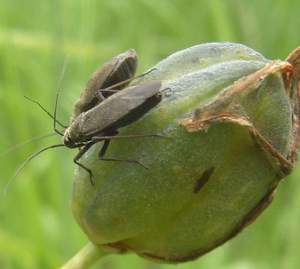Stink Bugs and Seed Bugs in New England
By Chris Williams on August 21, 2013.
 We’re approaching that time of year (late summer/early fall) when we can expect to be visited by those fall-invading insects that like to spend the winter in our homes. Our two newest fall invaders are the brown marmorated stink bug and the western conifer seed bug.
We’re approaching that time of year (late summer/early fall) when we can expect to be visited by those fall-invading insects that like to spend the winter in our homes. Our two newest fall invaders are the brown marmorated stink bug and the western conifer seed bug.
These two pests are related, look similar, and are often confused. Both are mostly brownish-gray and what we call “shield-shaped,” with long antennae. The antennae of the stink bug are banded dark and light. The seed bug is larger and slimmer than the stink bug and has distinctive leaf-shaped flares on its hind legs. They don’t bite, but both can release a smelly defensive fluid if they are handled or threatened.
Both of these invasive species have become pests in our region in the last few years and their numbers have been increasing each year. The brown marmorated stink bug is a major crop pest in the Mid-Atlantic states where it was first found, and has been increasing its range. It has become a serious problem for growers (especially fruit growers) in the Mid-Atlantic because, thanks to global warming,it has been able to produce a second generation each summer. It’s assumed that it will be limited to one generation/year in New England’s shorter season. New England growers are hoping to find an answer before the stink bug population grows large enough to cause serious crop damage.
The western conifer seed bug is, as the name suggests, a western pest that has moved east and north in recent years. It feeds on the seeds and flowers of conifer trees like pine and spruce. It’s probably more common in our region than the stink bug (for now), but where stink bugs occur, they tend to occur in larger numbers than the seed bug.
Plant Pests Become Indoor Pests in Fall
Even though these two pests feed on crops and trees, for us they become pests when they try to move into our homes. And they’ll be trying that pretty soon as the weather cools. They start searching for overwintering sites from early September into the first half of October. Usually their overwintering sites are under bark, in leaf litter, under stones or debris, and similar protected outdoor locations. They tend to congregate on the outsides of buildings before they move to these sites and some will choose to overwinter instead in your house—if you let them.
Fortunately, these invaders don’t do any damage inside. They find hiding places in attics, wall voids, and other sites and quietly spend the winter. They can make a surprise appearance on warm winter days, and come spring, they will be trying to get back outside. They’re not easy to control once they get inside, however, so your best control is prevention—keeping them out in the first place.
How to Prevent an Invasion
Prevention means pest-proofing or sealing up openings and gaps and loose screens that let pests in. Prevention can also mean an exterior insecticide treatment around the outside perimeter of your home. This treatment—which must be done very soon—will keep the bugs from reaching your house in the first place. Give Colonial a call so we can schedule your preventive treatment for fall invaders. We can also advise you on pest-proofing, or do it for you.
born1945 / Foter.com / CC BY
Sign up for our biweekly email newsletter for more information about bugs and pests!